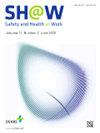Differences in Upper Extremity Muscle Activity, Neck Angle, and Body Discomfort Between Tablet Usage With Virtual Keyboard and Bluetooth Keyboard
IF 2.9
3区 医学
Q1 PUBLIC, ENVIRONMENTAL & OCCUPATIONAL HEALTH
引用次数: 0
Abstract
Background
The objective was to compare the differences in muscle activity of the upper extremities, neck angles, and body discomfort during tablet use between virtual and Bluetooth keyboards.
Methods
Twenty-four female volunteers were randomly assigned to use a tablet with keyboard for typing articles. The first order was randomly selected for 30 min, with a 30-minute break before the next keyboard layout test began.
Results
The result showed a statistically significant difference in the muscle activity of the upper trapezius while using a tablet between the two types of keyboards (p < 0.001). In addition, there were statistically significant differences in muscle activities of the upper trapezius (p < 0.05), extensor digitorum communis (EDC) (p < 0.001), and flexor digitorum superficialis (p < 0.001), craniohorizontal angle (p < 0.001) and craniovertebral angle (p < 0.001), and body discomfort in the neck and shoulder areas before and after using the tablet with each keyboard (p < 0.05).
Conclusion
Tablet use with the two types of keyboards induced an increase in muscle activity, neck flexion angles, and body discomfort, which may contribute to the occurrence of musculoskeletal disorders (MSDs). This study may serve as a basis for developing guidelines to reduce the risk of MSDs during tablet use.
使用虚拟键盘和蓝牙键盘的平板电脑对上肢肌肉活动、颈部角度和身体不适的影响
目的是比较虚拟键盘和蓝牙键盘在使用平板电脑时上肢肌肉活动、颈部角度和身体不适方面的差异。方法随机选取24名女性志愿者,使用带键盘的平板电脑打字。第一个顺序被随机选择30分钟,在下一次键盘布局测试开始前有30分钟的休息时间。结果两种键盘使用平板电脑时,斜方肌上部肌肉活动差异有统计学意义(p < 0.001)。此外,使用平板电脑前后,上斜方肌(p < 0.05)、指共伸肌(EDC) (p < 0.001)、指浅屈肌(p < 0.001)、颅水平角(p < 0.001)、颅椎角(p < 0.001)的肌肉活动以及颈部、肩部部位的身体不适程度差异均有统计学意义(p < 0.05)。结论平板电脑与两种键盘配合使用会导致肌肉活动增加、颈部屈曲角度增加、身体不适,可能是导致肌肉骨骼疾病(MSDs)发生的原因之一。本研究可作为制定指南的基础,以降低片剂使用过程中MSDs的风险。
本文章由计算机程序翻译,如有差异,请以英文原文为准。
求助全文
约1分钟内获得全文
求助全文
来源期刊

Safety and Health at Work
Social Sciences-Safety Research
CiteScore
6.40
自引率
5.70%
发文量
1080
审稿时长
38 days
期刊介绍:
Safety and Health at Work (SH@W) is an international, peer-reviewed, interdisciplinary journal published quarterly in English beginning in 2010. The journal is aimed at providing grounds for the exchange of ideas and data developed through research experience in the broad field of occupational health and safety. Articles may deal with scientific research to improve workers'' health and safety by eliminating occupational accidents and diseases, pursuing a better working life, and creating a safe and comfortable working environment. The journal focuses primarily on original articles across the whole scope of occupational health and safety, but also welcomes up-to-date review papers and short communications and commentaries on urgent issues and case studies on unique epidemiological survey, methods of accident investigation, and analysis. High priority will be given to articles on occupational epidemiology, medicine, hygiene, toxicology, nursing and health services, work safety, ergonomics, work organization, engineering of safety (mechanical, electrical, chemical, and construction), safety management and policy, and studies related to economic evaluation and its social policy and organizational aspects. Its abbreviated title is Saf Health Work.
 求助内容:
求助内容: 应助结果提醒方式:
应助结果提醒方式:


